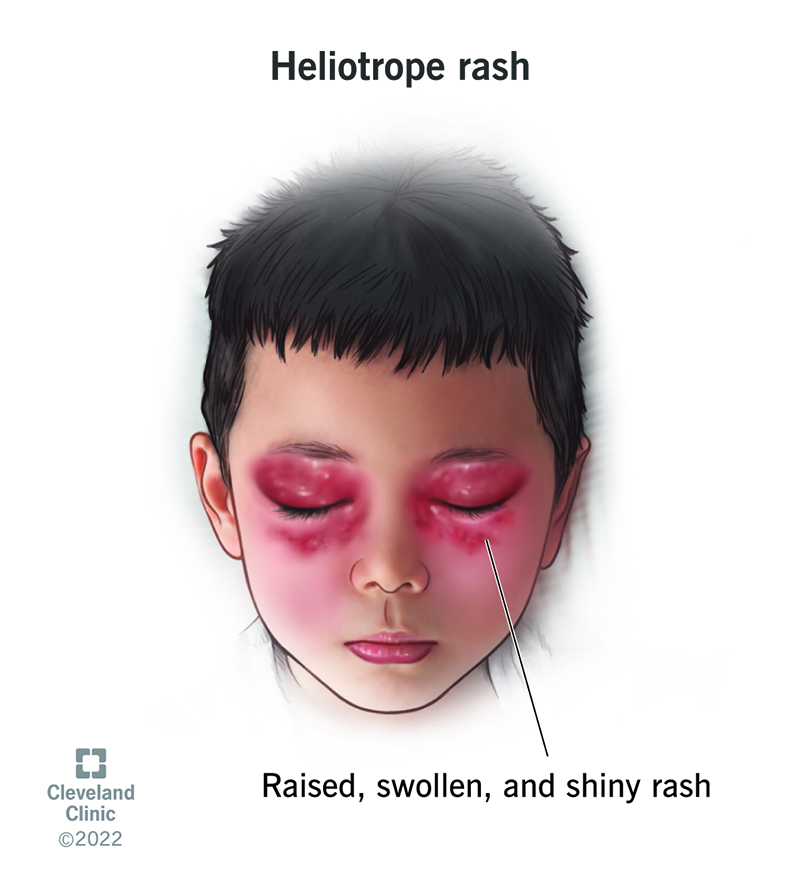A heliotrope rash is a dark or reddish-purple discoloration on your upper eyelids, often paired with swelling or discomfort. It’s a classic sign of dermatomyositis. This is a rare condition that affects both skin and muscles. If you notice this rash, especially with muscle weakness, talk to a provider.
Advertisement
Cleveland Clinic is a non-profit academic medical center. Advertising on our site helps support our mission. We do not endorse non-Cleveland Clinic products or services. Policy

A heliotrope rash is a dark or red to purple rash on or around your eyelids. It’s one of the most common signs of dermatomyositis. This is a rare but serious condition that causes inflammation in your skin and muscles.
Advertisement
Cleveland Clinic is a non-profit academic medical center. Advertising on our site helps support our mission. We do not endorse non-Cleveland Clinic products or services. Policy
The rash gets its name from the heliotrope (pronounced “HEE-lee-uh-trohp”) flower. It has a purple color similar to the skin changes seen in this condition.
If you notice new changes in your skin or muscles, it’s important to see a healthcare provider.
A heliotrope rash has the following features:
It usually targets both eyelids. It may affect just the top, but it can affect your top and bottom eyelids at the same time. If you’re Black, the only sign of this rash could be swelling around your eyes.
A heliotrope rash may feel:
A rash near your eyes can make it hard to see clearly. This is especially true if your eyelids swell.
Yes. This type of rash often flares up and then fades instead of staying on your skin all the time. How often it appears depends on the course of dermatomyositis. Treatment can help reduce how often flare-ups happen and make them less severe.
A heliotrope rash happens because of inflammation in the small blood vessels and skin around your eyes. The most common cause is dermatomyositis. This is an inflammatory condition where your immune system mistakenly attacks healthy skin and muscle cells.
Advertisement
When diagnosing a heliotrope rash, your healthcare provider may consider other conditions that have similar symptoms. This is called a differential diagnosis.
Possible conditions that may resemble a heliotrope rash include:
Your provider will use your medical history and physical exam to help make a diagnosis. They may also recommend blood tests or a skin biopsy, which is taking a sample of your skin. These tests help rule out other conditions to make an accurate diagnosis.
Treatment focuses on reducing inflammation and protecting your skin. Your healthcare provider may recommend:
Dermatomyositis also causes muscle weakness. If you have this symptom, too, your provider may recommend other treatments to manage this as well. You’ll likely need regular follow-up visits to adjust treatment and monitor your progress.
Your healthcare provider will give you specific instructions for caring for your skin at home. Their advice may include:
Because sunlight can make dermatomyositis symptoms worse, it’s important to protect your skin when outdoors. Use a broad-spectrum sunscreen (SPF 30 or higher), wear protective clothing and avoid prolonged sun exposure when possible.
Advertisement
See a healthcare provider if you have a rash that’s painful, itchy or not going away. It’s especially important to tell your provider if you also have muscle pain or weakness. These can be signs of dermatomyositis.
A heliotrope rash, caused by dermatomyositis, goes deeper than your skin. It can also affect your muscles. But it doesn’t stop there. Having a rash near your eyes can impact how you feel about yourself, too.
Don’t wait for the rash to go away on its own. It needs care from a healthcare provider. Treating the underlying condition can ease symptoms throughout your body and lower your risk of complications.
The sooner you get treatment, the sooner you can start feeling better.
Advertisement
Dermatomyositis can cause skin rashes and lead to severe muscle damage. Cleveland Clinic can help manage your symptoms and provide lifelong care.

Last reviewed on 11/17/2025.
Learn more about the Health Library and our editorial process.